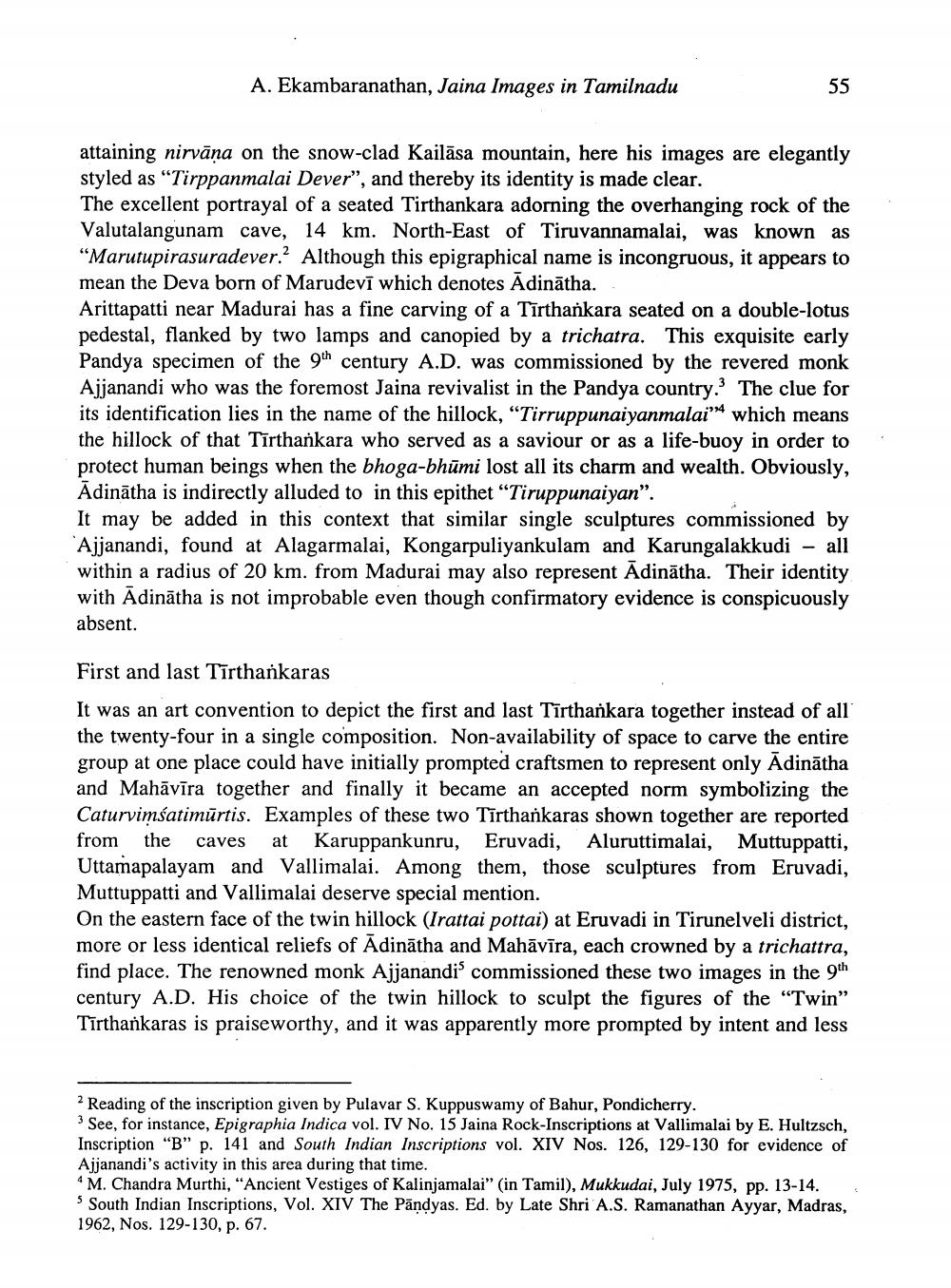________________
A. Ekambaranathan, Jaina Images in Tamilnadu
55
attaining nirvana on the snow-clad Kailasa mountain, here his images are elegantly styled as "Tirppanmalai Dever", and thereby its identity is made clear.
The excellent portrayal of a seated Tirthankara adorning the overhanging rock of the Valutalangunam cave, 14 km. North-East of Tiruvannamalai, was known as "Marutupirasuradever. Although this epigraphical name is incongruous, it appears to mean the Deva born of Marudevī which denotes Adinatha.
Arittapatti near Madurai has a fine carving of a Tīrthankara seated on a double-lotus pedestal, flanked by two lamps and canopied by a trichatra. This exquisite carly Pandya specimen of the 9th century A.D. was commissioned by the revered monk Ajjanandi who was the foremost Jaina revivalist in the Pandya country.' The clue for its identification lies in the name of the hillock, "Tirruppunaiyanmalai" which means the hillock of that Tirthankara who served as a saviour or as a life-buoy in order to protect human beings when the bhoga-bhūmi lost all its charm and wealth. Obviously, Adinatha is indirectly alluded to in this epithet "Tiruppunaiyan".
It may be added in this context that similar single sculptures commissioned by Ajjanandi, found at Alagarmalai, Kongarpuliyankulam and Karungalakkudi - all within a radius of 20 km. from Madurai may also represent Ādinātha. Their identity. with Adinatha is not improbable even though confirmatory evidence is conspicuously
absent.
First and last Tirthankaras
It was an art convention to depict the first and last Tirthankara together instead of all the twenty-four in a single composition. Non-availability of space to carve the entire group at one place could have initially prompted craftsmen to represent only Adinatha and Mahāvīra together and finally it became an accepted norm symbolizing the Caturvimsatimurtis. Examples of these two Tirthankaras shown together are reported from the caves Karuppankunru, Eruvadi, Aluruttimalai, Muttuppatti, Uttamapalayam and Vallimalai. Among them, those sculptures from Eruvadi, Muttuppatti and Vallimalai deserve special mention.
On the eastern face of the twin hillock (Irattai pottai) at Eruvadi in Tirunelveli district, more or less identical reliefs of Adinatha and Mahāvīra, each crowned by a trichattra, find place. The renowned monk Ajjanandi' commissioned these two images in the 9th century A.D. His choice of the twin hillock to sculpt the figures of the "Twin" Tirthankaras is praiseworthy, and it was apparently more prompted by intent and less
2 Reading of the inscription given by Pulavar S. Kuppuswamy of Bahur, Pondicherry.
3 See, for instance, Epigraphia Indica vol. IV No. 15 Jaina Rock-Inscriptions at Vallimalai by E. Hultzsch, Inscription "B" p. 141 and South Indian Inscriptions vol. XIV Nos. 126, 129-130 for evidence of Ajjanandi's activity in this area during that time.
4 M. Chandra Murthi, "Ancient Vestiges of Kalinjamalai" (in Tamil), Mukkudai, July 1975, pp. 13-14. South Indian Inscriptions, Vol. XIV The Pandyas. Ed. by Late Shri A.S. Ramanathan Ayyar, Madras, 1962, Nos. 129-130, p. 67.




